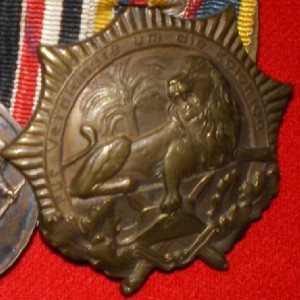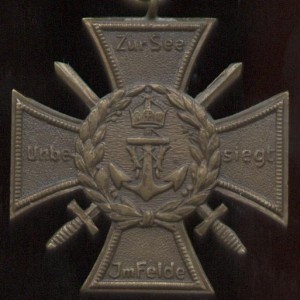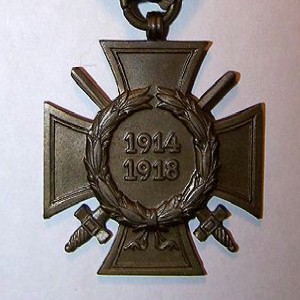| |
Post-1918 Overseas Veterans Medals
When the veterans of the colonial campaigns returned home after the
First World War they finally received the medals they had earned
during the war. Some of these medals had been approved in Africa
(such as the Hildegard Order substitute Iron Crosses) or Germany (such
as General Major von Lettow-Vorbeck's Pour-le-Mérite) during
the war and now had simply to be delivered to the recipient.
Others (such as the Wound Badge) had to be awarded retrospectively. The German
Colonial Veterans League ("Deutschen
Kolonialkriegerbund") was still making retrospective
recommendations for awards of the Iron Cross up until 1925.
As all the German
monarchies had abdicated, the regulations they had authorised
were no longer rigidly applied. Variations in the manner of
wearing medals and in the order of seniority on medal bars
became common. New official awards (such as the 1914-18
Honour Cross) and semi-official awards (such as the Elephant
and Lion Orders) were also created in the years after 1918.
Unofficial campaign clasps were sometimes privately
purchased bars for wear on medals. For example, clasps for
the second class Iron Cross with "OSTAFRIKA", "SÜDWESTAFRIKA",
"KAMERUN", "TOGO", "SÜDSEE", "TSINGTAU", "KIAUTSCHOU" and "PALÄSTINA" were advertised
for order by medal maker Heinrich Timm in the early 1930s.
Such unofficial clasps were banned under regulations passed
on 14th November 1935. Numerous other unofficial badges were worn by veterans associations.
Recommended Reading -
"For
Valour - The history of the Iron Cross and Wound Badge in German
Southwest Africa 1914-1918" by Gordon McGregor
Recommended External Links -
GWPDA Page on Post-War Medals and
Traditionsverband article on
Colonial Veterans Badges
| Elephant Order |
|

Photo ©
Captain George Albert |
|
The Elephant Order ("Elefantenorden"
or more correctly the "Kolonial-Abzeichen") was
instituted by the Minister for Reconstruction in 1921 for
all veterans of active service in the colonies in the First
World War 1914-18. The award was a round white metal badge
worn on the left breast showing an elephant over an oak leaf
wreath below the titles "Südsee Afrika Kiautschou".
The Elephant Order was a semi-official award and although it
was often worn on post-war army ("Reichsheer")
uniforms it was not listed in their rank lists. It was
however curiously listed in the rank lists of the navy ("Reichsmarine")
of the period.
This particular
Elephant
Order was awarded to
Rear Admiral Walther Koehler. He served in East
Africa during the Maj-Maji Rebellion 1905-07,
and was one of only eighteen seamen to survive
the sinking of the SMS Leipzig at the Battle of
the Falkland Islands in 1914 as part of Graf von
Spee’s East Asiatic Squadron.
Recommended External Link -
Traditionsverband article on the
Elephant Order, a discussion on the
Elephant Order at the
Gentlemen's Military Interest Club
and a
Walther Koehler Biography on Iron Cross |
|
|
|
|
|
Lion Order |
|
|
|

Photo © Captain George Albert |
|
The Lion Order ("Löwenorden" or more correctly
the "Kolonialauszeichnung") was instituted by the
German Colonial Veterans League ("Deutschen
Kolonialkriegerbund") in 1922.
It came in two classes,
silver or white metal (to all veterans of the Schutztruppe,
East Asian army and Imperial navy who had served in the
colonies) and bronze (to Germans who had done valuable work
for the colonies back home). The first class award in white
metal was worn as a breast badge and the second
class in bronze was worn on the medal bar.
The award was an eight pointed
star badge worn on the left breast showing a lion and palm
tree over a Sudwester hat and crossed swords over oak
leaves. Above the lion was the script "Für Verdienste um
die Kolonien".
As an award of the Colonial League rather
than one instituted by the state it had no official status.
Recommended External Link -
Traditionsverband article on the
Lion Order |
|
|
|
|
|
Flanders Cross |
|
|
|

Photo by Joachim Specht
on WikiCommons |
|
The Honour
and Remembrance Cross of the Flanders Naval Corps ("Ehren- und Erinnerungskreuz des Marinekorps Flandern",
more commonly called the "Flandernkreuz") was an unofficial
medal awarded in 1921 to the veterans of the
imperial naval "Marinekoprs Flandern"
who served on the Western Front during the First World War.
The award consisted of a bronze cross
with swords. On the obverse of the cross was a crowned "W" monogram
over a wreathed anchor and the motto "Zur See Im Felde unbesiegt" (roughly
translated as "Undefeated on the
seas and in the field"). The reverse showed a wreathed
imperial naval flag with the lion of Flanders above it and the motto
""MARINE KORPS 1914/18". The ribbon was vertically striped
black/white/red/black,red/white/black.
Recommended External Link -
Weimar Medals at the GWPDA
|
|
|
|
|
|
Wound Badge |
|
|
|

Photo ©
Peter Klein |
|
The Wound Badge ("Verwundetenabzeichen") was instituted on 3rd March 1918 and awarded to all
those wounded by enemy action in the First World War. It was
commonly worn on European (and Palestinian) fronts during
the last months of the war but was only awarded to colonial
veterans retrospectively when they returned to Germany after
the war.
The army (and
Schutztruppe) award consisted of a metal badge showing a
steel helmet and crossed swords within a laurel wreath. The
naval award was similar but with an anchor instead
of the steel helmet (see left).
The badge was worn on
the lower left breast below other medals. It came in three
classes, black for one or two wounds, silver for three or
four wounds and gold for five or more wounds or loss of a
limb, sight or other form of permanent
disablement.
Highly Recommended Reading -
"For
Valour - The history of the Iron Cross and Wound Badge in German
Southwest Africa 1914-1918" by Gordon McGregor |
|
|
|
1914-18 Honour Cross |
|

Photo from
WikiCommons |
|
The 1914-18 Honour Cross ("Ehrenkreuz") popularly
known as the Hindenburg Cross was instituted on 13th July
1934 by German President Paul von Hindenburg for all veterans of the
First World War, colonial and otherwise. At the time of its
introduction it superseded and replaced all
semi-official awards (such as the Elephant and Lion
Orders and the Flanders Cross).
The medal was a bronze
cross with crossed swords and the dates "1914" and "1918" in
the centre surrounded by a laurel wreath. The ribbon was
vertically striped black/white/black/red/black/white/black. Non-Combatants received the same medal but without
the crossed swords. A similar medal for the next-of-kin of those
killed in the war was awarded in black, without swords and with the
ribbon colours reversed. |
|
|